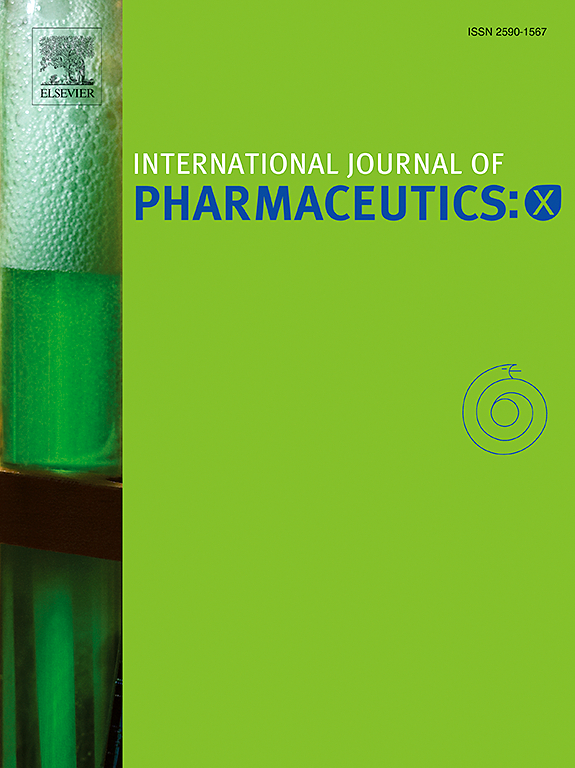用于肠道炎症治疗和管理的仿生纳米载体
IF 6.4
2区 医学
Q1 PHARMACOLOGY & PHARMACY
引用次数: 0
摘要
肠道炎症,特别是炎症性肠病,由于其慢性性质,治疗效果有限,以及皮质类固醇和生物制剂等常规疗法的不良反应,给临床带来了重大挑战。仿生纳米载体的出现是一种变革性的策略,通过利用天然细胞膜进行靶向药物递送来克服这些限制。本文综述了仿生纳米载体在肠道炎症精准治疗中的应用。我们讨论了关键的制造技术,包括挤压、超声和微流体,用于在合成纳米载体上涂覆来自几种生物来源的膜,如巨噬细胞、中性粒细胞、血小板、干细胞和细菌。这些仿生涂层利用固有的生物功能,如免疫逃避、受体介导的与炎症内皮的结合和对炎症刺激的反应。临床前研究表明,仿生纳米载体可有效抑制NF-κB、NLRP3等促炎途径,隔离细胞因子,促进粘膜愈合,恢复肠道菌群平衡,同时最大限度地减少全身毒性。尽管在动物模型上取得了令人鼓舞的结果,但临床翻译在膜分离标准化、长期生物安全性和监管一致性方面面临障碍。未来的进展需要跨学科的努力来优化药代动力学,增强组织特异性靶向,并整合个性化设计。仿生纳米载体代表了疾病修饰疗法的范式转变,为肠道炎症管理提供了持续缓解的潜力。本文章由计算机程序翻译,如有差异,请以英文原文为准。

Biomimetic nanocarriers for the therapy and management of intestinal inflammations
Intestinal inflammation particularly inflammatory bowel disease poses significant clinical challenges due to its chronic nature, limited treatment efficacy and adverse effects of conventional therapies like corticosteroids and biologics. Biomimetic nanocarriers have emerged as a transformative strategy to overcome these limitations by leveraging natural cell membranes for targeted drug delivery. This review critically examines the application of biomimetic nanocarriers as precision therapeutics for intestinal inflammation. We discuss key fabrication techniques including extrusion, sonication and microfluidics used to coat synthetic nanocarriers with membranes derived from several biological sources such as macrophages, neutrophils, platelets, stem cells and bacteria. These biomimetic coatings exploit inherent biological functions such as immune evasion, receptor-mediated binding to inflamed endothelium and responsiveness to inflammatory stimuli. Preclinical studies demonstrate that biomimetic nanocarriers effectively suppress pro-inflammatory pathways like NF-κB, NLRP3, sequester cytokines, promote mucosal healing and restore gut microbiota balance while minimizing systemic toxicity. Despite promising outcomes in animal models, clinical translation faces hurdles in membrane isolation standardization, long-term biosafety, and regulatory alignment. Future advancements require interdisciplinary efforts to optimize pharmacokinetics, enhance tissue-specific targeting, and integrate personalized designs. Biomimetic nanocarriers represent a paradigm shift toward disease-modifying therapies, offering potential for sustained remission in intestinal inflammation management.
求助全文
通过发布文献求助,成功后即可免费获取论文全文。
去求助
来源期刊

International Journal of Pharmaceutics: X
Pharmacology, Toxicology and Pharmaceutics-Pharmaceutical Science
CiteScore
6.60
自引率
0.00%
发文量
32
审稿时长
24 days
期刊介绍:
International Journal of Pharmaceutics: X offers authors with high-quality research who want to publish in a gold open access journal the opportunity to make their work immediately, permanently, and freely accessible.
International Journal of Pharmaceutics: X authors will pay an article publishing charge (APC), have a choice of license options, and retain copyright. Please check the APC here. The journal is indexed in SCOPUS, PUBMED, PMC and DOAJ.
The International Journal of Pharmaceutics is the second most cited journal in the "Pharmacy & Pharmacology" category out of 358 journals, being the true home for pharmaceutical scientists concerned with the physical, chemical and biological properties of devices and delivery systems for drugs, vaccines and biologicals, including their design, manufacture and evaluation. This includes evaluation of the properties of drugs, excipients such as surfactants and polymers and novel materials. The journal has special sections on pharmaceutical nanotechnology and personalized medicines, and publishes research papers, reviews, commentaries and letters to the editor as well as special issues.
 求助内容:
求助内容: 应助结果提醒方式:
应助结果提醒方式:


